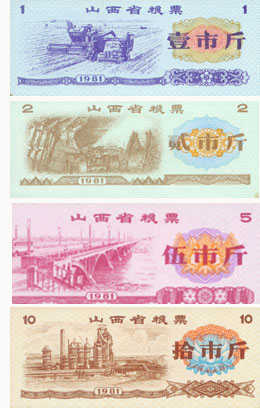China’s commodity ration coupons
 China began issuing commodity ration coupons (known as liang piao) in the 1950s, with specific coupons issued for foodstuffs, fuel, even bicycles. Without them you were not permitted to purchase the goods. The system, which was only finally abolished in 1995, ensured that under the collective system, everyone got their fair share. Pictured are food coupons, with the unit measurement denoting the weight (not currency) of the produce. Measured in jin (about 0.5 kilo) these depict ration coupons for 10, 5, 2 and 1 jin.
China began issuing commodity ration coupons (known as liang piao) in the 1950s, with specific coupons issued for foodstuffs, fuel, even bicycles. Without them you were not permitted to purchase the goods. The system, which was only finally abolished in 1995, ensured that under the collective system, everyone got their fair share. Pictured are food coupons, with the unit measurement denoting the weight (not currency) of the produce. Measured in jin (about 0.5 kilo) these depict ration coupons for 10, 5, 2 and 1 jin.
These particular coupons were issued in Shanxi Province in 1981 and were used for the allocation and purchase of rice and grain. The average ration was 15 kilograms for a man and 13 kilograms for a woman each month, though it varied somewhat with age, profession and location. These coupons were given per person, no matter how poor or rich that person was, therefore these food ration coupons (also known as rice coupons) were and are much scarcer than Chinese RMB yuan bank notes.
With rising inflation a growing concern for Beijing, the Guangdong People’s Congress has proposed reintroducing the food rations to ensure that low-level income families have access to basic necessities.
This China cultural article is one of a regular series we are running at China Briefing. Conducting business in China is more than just legal and tax advice, one has to “feel” the country and its rhythms as well in order to properly advise clients on conducting business in this massive country. These China cultural articles are intended to assist with a greater business understanding of the background to doing business in China, and are provided by the research team at Dezan Shira & Associates. To view the China business cultural archives, please click here.
- Previous Article Olympic Marathon World Record Athlete Threatens Beijing Air Quality Pull Out
- Next Article Beijing Olympics becoming politicized, UK Olympic Association backs down after stand-off with athletes









